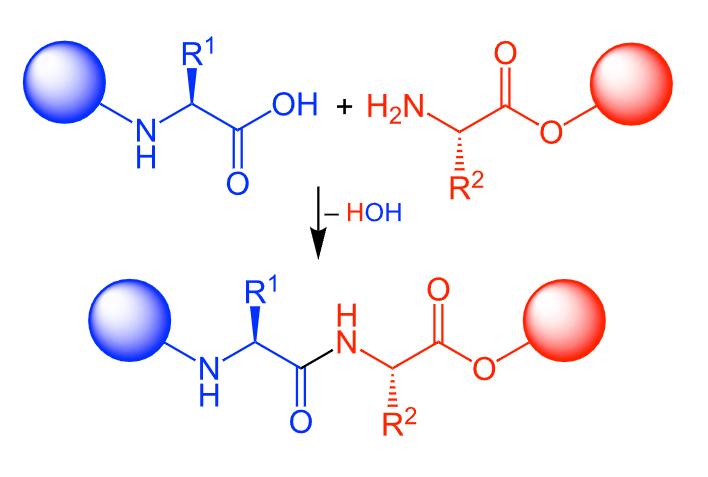What’s the difference between peptides vs. proteins in stem cells? Furthermore, how do amino acids fit in? They all come together in sequence, of course. Amino acids make up peptides, and peptides make up proteins. That sounds simple enough, but what about peptides vs. proteins in stem cell research and production? We will discuss exactly that in this article, along with R-chains and molecules.
Peptides vs. Proteins Plus R-Chains and Amino Acids
Peptides are not molecules. Rather, they contain molecules and amino acids. Each peptide contains a central Carbon atom that’s attached to a Hydrogen atom, an acid molecule, a base molecule, and an R-chain. The R-chain, or R-group, can vary greatly and is a side chain that determines the versatility of the amino acid and its purpose within cell biology.
Alanine (Ala), Arginine (Arg), and Cysteine (Cys) are three basic amino acids. Since they all contain an amine called NH2, they all end in -ine. The “N” in each amine signifies that it is attached to a Nitrogen molecule. As they recombine, however, they accrue additional names. The Carbon and Nitrogen molecules form a peptide bond, and the peptides are named according to the various amines that they contain.
When multiple peptides attach to one another, they’re called polypeptides. Peptides and polypeptides carry the amino acids which, as you might remember from sixth-grade science class, are the building blocks of proteins. But let’s set aside amines and amino acids for now. This article is about the role that peptides vs proteins play in stem cell research and therapy.
Peptides and Proteinogenic Amino Acids
Each peptide contains Carbon, which isn’t so surprising considering that we’re all carbon-based life forms. Each peptide also contains the other required molecule and the R-chain. The chemistry of these R-chains determines the function of the molecule and whether or not it can serve as a protein in stem cells. There are 22 so-called proteinogenic amino acids that differ by R-chain content.
What are the names of these proteinogenic amino acids? It’s a long list that includes Arginine, Histidine, Lysine, Aspartic Acid, Glutamic Acid, Serine, Threonine, Asparagine, Glutamine, Glycine, Proline, Cysteine, Alanine, Valine, Isoleucine, Leucine, Methionine, Phenylalanine, Tyrosine, Tryptophan, Selenocysteine, and Pyrrolysine.
Importantly, all of these proteinogenic amino acids can form peptides and polypeptides, undergoing conversion into proteins. Scientists were able to isolate this ability for the first time in 1920. That’s when they cultured cells that differentiated to produce insulin, a small protein chain or polypeptide hormone that tells the body’s cells to absorb sugar. This 1920 experiment was the first time that a peptide was used for cellular manipulation or differentiation.
How Proteins Can Be Applied to Regenerative Therapeutics
By the time that insulin was used for cellular therapies, scientists were already studying peptides through mass spectrometry, stoichiometry, and other techniques. Scientists were also analyzing the cost of metabolism to the cell to determine which proteins could potentially be utilized to self-renew or differentiate with therapeutic value for humans.
Research revealed that some proteinaceous amino acids condensed more readily than others, and scientists were amazed at the arrangement of patterns that identified the proteinaceous peptides were literally the building blocks of life. Besides the creation of insulin, clinicians over the years have worked with proteins that impact pluripotent stem cells, mesenchymal stem cells, and other types of cell therapies.
Mesenchymal stem cells can be differentiated to produce tissues of the skeleton and chondrogenic tissues. There are human periodontal ligament stem cells that can be harvested from six places in the mouth, and they are also used for the research of neurological diseases. Each of these cell types relies on specific proteins and peptides to maintain their function. There are short peptides with the mission of signaling DNA and interacting with histone proteins as regulators. Others inhibit the growth of embryonic cells and cells that are immortalized; scientists suspect they contain inherent anti-tumor properties.
Peptides vs. Proteins: What you need for stem cell research
Now that we understand the difference between a peptide and a protein, it becomes clearer what is needed for stem cell research. For all cell types, proteins control cellular pathways, regulating metabolism, growth, and decay. Stem cells are no different, and they rely heavily on specific growth factor proteins to control their growth, differentiation, and proliferation. One such growth factor is fibroblast growth factor 2, known as FGF2.
Because peptides are composed of amino acids, the building blocks of proteins, they impact the protein’s function and how proteins interact within cells. Scientists select and include the proteins in their culture conditions that have the right chemical properties to properly maintain their cells. Although scientists are not adding peptides specifically into their cultures, they are utilizing the characteristics of peptides through the use of their formed proteins. Scientists need proteins for proper cell culture, and proteins need peptides for proper structure and functionality.
There remains a great deal of knowledge to uncover regarding the minuscule structures of the simple cell. Understanding the differences between peptides vs. proteins is an important place to start.
